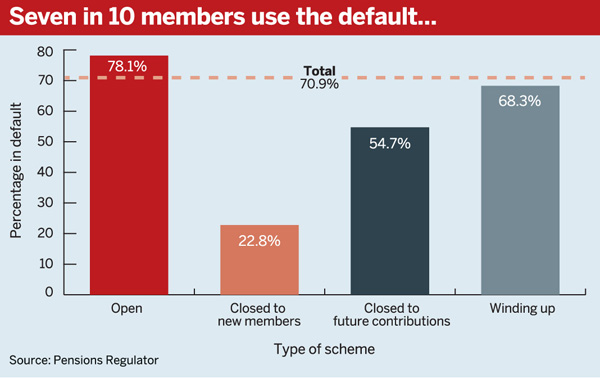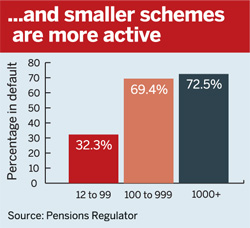Data analysis: Fewer defined contribution members than expected are invested in default funds, new figures have shown, but experts anticipate this to increase as auto-enrolment continues to roll out.
DC scheme design has largely focused on how the default is set up, in the belief that the vast majority of scheme members will end up there, with the government citing figures showing 80-90 per cent make no active decision.

Data published last week by the Pensions Regulator show around 70 per cent of members are currently sitting in their scheme’s default fund. Larger, open pension schemes have the highest proportion making no active investment choice.
Those closed to new contributions have just one in five members in the default (23 per cent), and those closed to future contributions around half (55 per cent). These lower figures could be because schemes were only mandated to put in place default funds when stakeholder plans were established in 2001.
They may also have updated their default fund, with a number of members remaining in the older fund and therefore not part of the default. “The older schemes are more likely to have a change of default,” said Adrian Boulding, pensions strategy director at Legal and General.
“As communicators, we are going to have to go back and redouble our efforts [to inform members] that there is an up-to-date default fund,” he added.
Members joining the default rather than making active investment decisions can be a good thing, experts have said.
“You might make great decisions when you join the plan but you’re probably not going to be looking at it every week, month or even year,” said Nigel Aston, head of UK DC at State Street Global Advisors.
The number of members in a default fund should increase as auto-enrolment is rolled out to more employees.
“Our research [shows] trustees, plan sponsors and providers in the commercial market spend a lot [more] time on designing the default than on looking at the range, and that is exactly how it should be because more people go into the default,” said Andy Cheseldine, partner at consultancy LCP.
Schemes should focus on designing an effective default fund that is tailored to its members’ profile, including their contribution capabilities and risk appetite, said Will Aitken, head of DC consulting at Towers Watson.
Managers and trustees should also concentrate on getting members to pay as much as they can in contributions, said Aitken, and only when this is achieved, should they focus on trying to educate members on investment decisions.
“Rather than talking about equities and bonds, [schemes] should discuss how volatile these things are, what they’re trying to do,” he added.














